Greenbelt (Golden Horseshoe)
The Greenbelt is a permanently protected area of green space, farmland, forests, wetlands, and watersheds, located in Southern Ontario, Canada. It surrounds a significant portion of Canada's most populated and fastest-growing area, the Golden Horseshoe.
| Ontario's Greenbelt | |
|---|---|
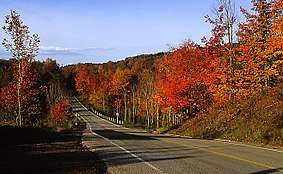 | |
| Location | Southern Ontario, Canada |
| Area | 7,200 square kilometres (2,800 sq mi) |
| Established | 2005 |
| www | |
Created by legislation passed by the Government of Ontario in 2005, the Greenbelt is considered a major step in the prevention of urban development and sprawl on environmentally sensitive land in the province. The Government of Ontario states that the Greenbelt includes 800,000 acres (323,748.5 hectares) of land protected by the Niagara Escarpment Plan and the Oak Ridges Moraine Conservation Plan plus 1 million acres (404,685.6 hectares) of land in the Protected Countryside overarching Greenbelt Plan.[1] That total (7,284 km² or 2,812 mi²) makes it one of the largest and most successful greenbelts in the world.[2][3] The previous Government of Ontario had committed to increasing its size in the future.[4]
History
The Greenbelt was established around the Golden Horseshoe, one of the fastest growing urban areas in North America.[2] The population in the region increased from 6.5 to 7.7 million between 1991 and 2001.[5] The population increase put urban development pressure on areas surrounding Greater Toronto and Hamilton. Between 1996 and 2001, the amount of farmland decreased by 7% in the GTA, and by 6% in Hamilton.[2] The Golden Horseshoe's population is projected to increase to 11.5 million by 2031.[5]
The idea of establishing a greenbelt in Ontario was created by Premier of Ontario Dalton McGuinty in his Speech from the Throne in November 2003. Bill 27, the Greenbelt Protection Act, 2004 became law on June 24, 2004. The new legislation, in conjunction with a zoning order issued by the Minister of Municipal Affairs and Housing, created a study area and placed a moratorium on some land uses until a specific plan was established. Bill 135, the Greenbelt Act, 2005 was introduced to the Legislative Assembly of Ontario for first reading of the bill in October 2004, and became law on February 28, 2005. It now provides permanent protection for the Greenbelt area.[6]
Purpose and composition
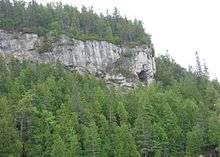
The Greenbelt provides regulatory protection from urban development pressure due to this population growth. While protecting prime agricultural land is its primary purpose, it is actually a bundle of other key elements to also protect rural area, heritage sites, and sensitive ecological and hydrological features, which include the Niagara Escarpment and the Oak Ridges Moraine.[7]
Protected Countryside
Agriculture protection is the primary element of the Greenbelt legislation. It prevents municipalities from re-zoning areas identified as "prime agricultural areas," "specialty crop areas," and "rural areas" identified by the province for other uses. The three areas compile the Protected Countryside (PC) element.[7] The PC includes areas like the Holland Marsh, which produces over $50 million of carrots, onions and other popular vegetables in very fertile soil.[8] Other fruits and vegetables, dairy, beef, pork, poultry, and wine grapes are produced throughout the region.[2]
Niagara Escarpment
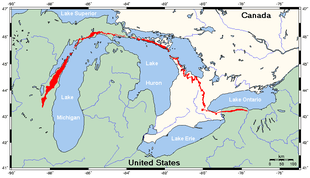
The Niagara Escarpment Biosphere Reserve is a geological formation that is the most prominent of scenic landforms in Ontario, reaching 725 kilometres long and up to 500 metres tall. It began as coastline of the Michigan Basin 450 million years ago.[9] It was designated as one of 15 UNESCO World Biosphere Reserves in Canada in 1990. It is managed jointly by Ministry of Natural Resources and the Niagara Escarpment Commission. The area is protected due to the many unique species and prime recreation grounds. Tourism associated with the escarpment contributes $100 million to local and regional economies.[9]
Oak Ridges Moraine
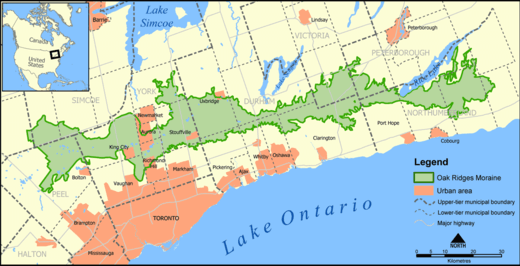
The Oak Ridges Moraine covers a 1,900 square kilometres (734 sq mi) between Caledon and Rice Lake, near Peterborough. It is a hydrological system of streams, wetlands, kettle lakes and ponds and their catchment areas, seepage areas, springs, and aquifers and other recharge areas.[10]
Current conservation, recognition and future
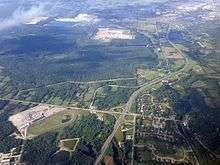
The Friends of the Greenbelt Foundation is a not-for-profit organization that was created in 2005 to help foster the Greenbelt in Southern Ontario. The Foundation, which was provided $25 million from the provincial government, has funded many organizations and charities in the Greenbelt, which support agricultural and viticultural activities and restoring the natural environment.
The Foundation is also responsible for providing a "Friend of the Greenbelt" award that serves to "recognize and celebrate those individuals who make a significant contribution to Ontario's Greenbelt." In 2006, singer Sarah Harmer was selected by the Foundation for her "I love the Escarpment" tour, which aims to protect the Niagara Escarpment. In 2007, former Premier William Grenville Davis was presented with the award for adopting the 1973 Niagara Escarpment Planning and Development Act, which created the Niagara Escarpment Plan.
A report titled Ontario’s Greenbelt in an International Context was released in 2010 by the Canadian Institute for Environmental Law and Policy. The report concluded the Ontario greenbelt is the strongest for its supporting legislation versus nine similar greenbelts internationally.[11]
A report titled GTHA Rural Property Inequities was released in 2015 in the Township of Scugog. This report concluded the Ontario greenbelt has many issues to overcome before it is a viable and sustainable proposition. It also concludes many of the supporters of the greenbelt are from metropolitan areas and don't contribute monetarily to its welfare.[12]
Future
In 2015, the Greenbelt Plan started its 10-year review in coordination with the Growth Plan for the Greater Golden Horseshoe, the Niagara Escarpment Plan, and the Oak Ridges Moraine Conservation Plan. As part of the review, the Province is gathering public feedback through a series of community meetings and online.[13] The Province has released a discussion document to "help inform and guide discussions."[14] The deadline for feedback on the proposed changes for the Co-ordinated Land Use Planning Review was 31 October 2016 and the Provincial Government expected to release specifics about the future plan in "early 2017".[15]
The Building Industry and Land Development Association, a lobby group for the development and construction industry in Ontario, claims that the Greenbelt and other anti-sprawl policies are responsible for the lack of affordable housing in southern Ontario.[16] Urban planners dispute this, stating that large amounts of land in southern Ontario set aside for development remained unused as of 2016 and would be sufficient to support over a decade of new development.[17]
In spite of pressure from realtors and home builders to decrease the size of the Greenbelt to allow for expansion of housing developments, Premier Kathleen Wynne told the news media that the 27 April 2017 Provincial Budget will not diminish the protected lands. "We're committed to growing the Greenbelt not shrinking the Greenbelt," she explained.[4] According to the Neptis Foundation (a publisher of nonpartisan research on urban regions), there are roughly 45,000 acres still available for development in the GTHA, adequate until at least 2031.[18]
Research conducted by the CBC confirms that a great deal of land is available in both Halton Region and Toronto; for example 6,000 and 118,610 housing units, respectively, have been approved but not built. Oakville Mayor Rob Burton commented to the CBC about developers in late March 2017 that "we've given them serviced land they're sitting on." Toronto's Chief Planner Jennifer Keesmaat added that "builders control supply in this region. We live in a cartel economy."[19]
In late April 2018, however, during the 2018 Ontario general election campaign, Doug Ford, leader of the Ontario Progressive Conservative Party discussed the Greenbelt in a video released to the news media.[20] Ford said that he would open the protected area to development if he was elected. His assurance to developers was made on the claim that the cost of new homes in the GTA and Hamilton area could be reduced if additional land were made available. Tim Gray, executive director of the environmentalist group Environmental Defence,reminded the news media that "municipal data shows that there is enough land available to provide for housing development within existing Greater Toronto and Hamilton Area urban boundaries until 2031."[21][22] The next day, Ford reversed his position and said he would not develop the protected area.[23]
See also
- Greenbelt (Ottawa) - Greenbelt surrounding the National Capital Region
- Politics of the Oak Ridges Moraine
- Rouge Park
- Agricultural Land Reserve
Notes
- "Greenbelt Protection". Ministry of Community Affairs. Government of Ontario. 28 February 2017. Retrieved 17 April 2017.
- The Friends of the Greenbelt Foundation. "Greenbelt Facts and Figures". Retrieved 3 January 2011.
- Martin Mittlestaedt (10 April 2008). "Ontario's greenbelt a model for the world". The Globe and Mail. Retrieved 3 January 2011.
- Benzie, Robert (29 March 2017). "Greenbelt won't be loosened to ease housing prices, says Wynne". Toronto Star. Toronto. Retrieved 17 April 2017.
- Hemson Consulting (January 2005). "The Growth Outlook for the Greater Golden Horseshoe" (PDF). Greater Golden Horseshoe Forecast Committee. Retrieved 3 January 2011.
- Deaton and Vyn, p. 142-143.
- Deaton and Vyn, p. 143
- "The Holland Marsh Drainage System Joint Municipal Services Board". Retrieved 3 January 2011.
- "About the Niagara Escarpment - Overview". Retrieved 15 January 2011.
- Bradford, Andrea; Stephen Maude. "Achieving Ecological Integrity on the Oak Ridges Moraine: Towards Ecologically Relevant Water Management" (PDF). University of Guelph. Retrieved 2006-06-16.
- Carter-Whitney & Esakin, p. 3
- GTHA Rural Property Inequities
- Ontario Ministry of Municipal Affairs and Housing. "Co-ordinated Land Use Planning Review". Retrieved 13 April 2015.
- Ontario Ministry of Municipal Affairs and Housing. "Our Region, Our Community, Our Home - A discussion document for the 2015 co-ordinated review". Retrieved 13 April 2015.
- "Co-ordinated Land Use Planning Review". Ministry of Municipal Affairs. Government of Ontario. 11 January 2017. Retrieved 17 April 2017.
the province has been undertaking the following actions in response to the Advisory Panel recommendations and what was heard in the consultations of spring 2015:Considering possible expansion of the Greenbelt outside of the Greater Toronto and Hamilton Area where important water resources are under pressure from urban growth Obtaining detailed technical information from municipalities, conservation authorities and landowners in the Greater Toronto and Hamilton Area to determine if further refinements to the Greenbelt are required. This will also help us determine impacts on specific properties. Supporting implementation through guidance documents and the mapping of natural heritage and agricultural systems outside the Greenbelt.
- Artuso, Antonella (29 January 2017). "Greenbelt forcing up home prices in GTA: Critics". Toronto Sun. Retrieved April 3, 2020.
- Gray, Jeff (October 14, 2016). "Is the greenbelt squeezing Toronto's housing market?". The Globe and Mail. Retrieved April 3, 2020.
- Smith Cross, Jessica (10 April 2017). "Ontario's anti-sprawl restrictions not a factor in housing shortage, government says". National Post. Toronto. Retrieved 17 April 2017.
- Grant, Amanda (31 March 2017). "Oakville Mayor says developing greenbelt won't cool housing market". CBC News. Canadian Broadcasting Corporation. Retrieved 17 April 2017.
- http://torontosun.com/news/provincial/doug-ford-would-open-greenbelt-for-some-development
- https://environmentaldefence.ca/2018/04/30/whos-playing-politics-greenbelt/
- https://www.thestar.com/news/queenspark/2018/04/30/doug-ford-assured-developers-he-plans-to-open-up-greenbelt-to-housing-development.html
- https://www.guelphmercury.com/news-story/8582112-ford-reverses-course-on-greenbelt-development-says-he-ll-maintain-protected-area/
Further reading
- Deaton, B. J., and Vyn, R. J. (2010). The Effect of Strict Agricultural Zoning on Agricultural Land Values: The Case of Ontario's Greenbelt. American Journal of Agricultural Economics Advance. Oxford University Press.
- Carter-Whitney, M., and Esakin, T. C. (2010). Ontario's Greenbelt in an International Context. Canadian Institute for Environmental Law and Policy.
